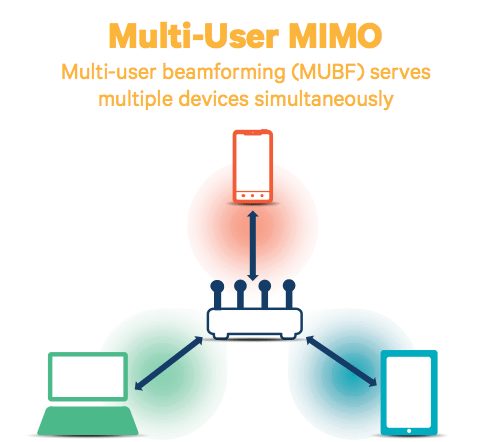Wi-Fi connectivity is the first thing many people look for when they enter a hotel, restaurant or airport waiting area. But many Wi-Fi access points are facing the same challenge that plagues cellular networks: too many people downloading too much data.
“We’re starting to see in public spaces, in enterprises, and increasingly in the home, that this model of the single-user sequential service is starting to show some weakness,” said Todd Antes, VP of product management at Qualcomm. “So a few years ago the Wi-Fi Alliance started looking at ways they could tackle this, and the approach they focused on was one that’s been used in the past in cellular systems, which is based on a technology called multi-user beamforming.”
Multi-user beamforming, which is also called multi-user MIMO, divides the signal spatially so that a device can simultaneously transmit multiple signals on the same frequency. “In our case our product will form up to three separate beams of information and communicate with up to 3 devices simultaneously,” said Antes. “So essentially in the same time slot that it took to communicate to one device in single-user mode it can now communicate to three devices. We’re transmitting on the same frequency but we’re spatially dividing the signal so only the intended client will hear it, the other two won’t.”
Multi-user beamforming accomplishes this by forming destructive nodes, canceling the signal for the non-intended clients in that space.
Beams vs. streams
Multi-user beamforming builds on another recent Wi-Fi advance, the use of multiple streams. The first release of the Wi-Fi Alliance’s 802.11ac standard boosted 802.11n speeds up to 200% by using three streams instead of one, and increased throughput by using wider channels and data encoding. Release 2 will increase speed and throughput even more, with four streams offering up to seven gigabits per-second, per-radio, even wider channels and multi-user beamforming (MU-MIMO).
Qualcomm is launching three-and four-stream 802.11ac MU-MIMO chipsets for routers and gateways, and will launch two separate chipsets with these features for enterprise access points. The company has also announced new Wi-Fi/Bluetooth chipsets for end user mobile devices. MU-MIMO requires an enabled chipset in both the Wi-Fi access point and the client.
“On the client side, we have a full range of devices to cover everything from mobile phones and tablets, notebooks, CE devices, and even your connected car, which when it parks in your garage can also be part of your network,” said Antes. The company’s Snapdragon 808 and 810 mobile processors also support MU-MIMO.
Go-to-market plans
Antes says Qualcomm’s solutions are in trials with 200 user devices and roughly 100 network appliances, like Wi-Fi routers and gateways. “We think there’s a really good story for home networks, enterprise networks, metro networks,” said Antes, noting that according to Machina Research the average U.S. home had seven connected devices by 2012. “The benefit of having an AP that is MU-MIMO capable is that it will be able to improve the throughput of those MU clients, but it will also improve the latency and the power consumption for all clients on the network. … We’ve created this kind of commuter line for those MU-MIMO clients which makes the entire network more efficient.”
“The ever-increasing number of connected devices in homes and businesses all require sufficient bandwidth to provide the best experience for users,” said Patrick Lo, CEO at NetGear. “MU-MIMO, as the next logical step in the 802.11ac evolution, fulfills this need, and Qualcomm’s early provisioning of this technology is timely.”
Follow me on Twitter.
Full disclosure: The author owns shares of Qualcomm.

